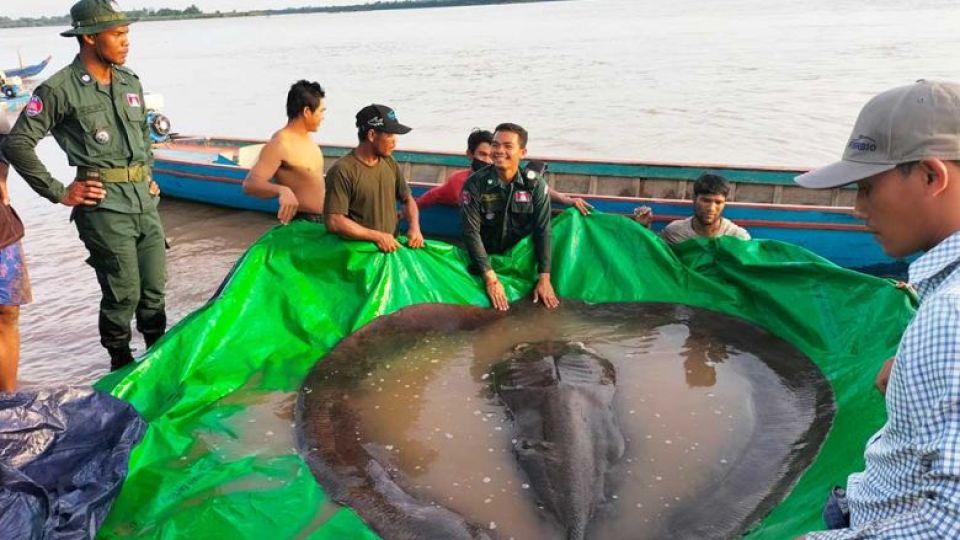June 23, 2022
PHNOM PENH – Scientists from Wonders of the Mekong and the Fisheries Administration (FiA) have set up 36 underwater acoustic receivers along the upper reaches of the Mekong River in Cambodia to better track the movements of a stingray believed to be the largest freshwater fish ever caught, excluding beluga sturgeons, which also occupy saltwater environments.
On June 13, a 42-year-old Cambodian fisherman, Moul Thun, a resident of Koh Preah village, Siem Bok district, Stung Treng province, caught the female giant freshwater stingray (Urogymnus polylepis), a species listed as “endangered” in the International Union for Conservation of Nature (IUCN) Red List.
The specimen reportedly weighed 300kg and measured 398cm from its snout to the tip of its tail, with a width of 220cm, which Wonders of the Mekong scientists noted dethroned the previous record-holder, a 293kg Mekong giant catfish caught in Thailand in 2005.
The stingray was released back into the Mekong on the evening of June 14, after it was weighed, fitted with an acoustic tag at the base of its tail, and named “Boramy” – which translates as “full moon” in Khmer – for the dusk moon shining on the horizon during its release, according to Chea Seila, the programme manager for the Wonders of the Mekong in Cambodia.
The three dozen acoustic receivers were set up along the Mekong between southwestern Kratie province where it meets Kampong Cham, to northern Stung Treng, up to the border with Laos’ Champasak province.
“These acoustic receivers are a new technology that allows biologists to understand the mysterious life processes and behaviours of living things, especially the world’s rarest and largest freshwater giant which we’ve just met and released,” Seila said.
She said the FiA, under the Ministry of Agriculture, Forestry and Fisheries, is involved in a conservation project that aims to establish a network of fishers to report catches of giant or endangered fish, including stingrays.
“We are very pleased and proud of the involvement of local fishers in the protection and conservation of rare and endangered fisheries in the Mekong River, such as the giant stingray,” she said. “We call them heroes, because without their participation, our efforts would not have been successful.”
The Mekong River originates in the Tibetan plateau, passes through China, Myanmar, Thailand, Laos, Cambodia and Vietnam, and is rich in biodiversity, but overfishing, dam construction and water pollution threaten the river’s fragile ecosystem.
Zeb Hogan, a US fish biologist at the University of Nevada, Reno who leads the Wonders of the Mekong, said: “The stingray find is evidence that the natural world can still yield new and extraordinary discoveries, and that many of the largest aquatic creatures remain woefully understudied.
“In 20 years of researching giant fish in rivers and lakes on six continents, this is the largest freshwater fish that we’ve encountered or that’s been documented anywhere worldwide.
“This is an absolutely astonishing discovery, and justifies efforts to better understand the mysteries surrounding this species and the incredible stretch of river where it lives,” he said.


